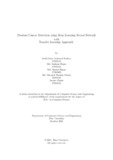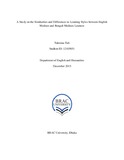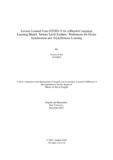| dc.contributor.advisor | Alam, Md. Golam Rabiul | |
| dc.contributor.advisor | Rashid, Warida | |
| dc.contributor.author | Badhon, Ariful Islam Mahmud | |
| dc.contributor.author | Hasan, Md. Sadman | |
| dc.contributor.author | Haque, Md. Samiul | |
| dc.contributor.author | Pranto, Md. Shafayat Hossain | |
| dc.contributor.author | Ghosh, Saurav | |
| dc.date.accessioned | 2022-03-14T09:02:09Z | |
| dc.date.available | 2022-03-14T09:02:09Z | |
| dc.date.copyright | 2021 | |
| dc.date.issued | 2021-10 | |
| dc.identifier.other | ID 17101314 | |
| dc.identifier.other | ID 17101413 | |
| dc.identifier.other | ID 17301169 | |
| dc.identifier.other | ID 18301238 | |
| dc.identifier.other | ID 17101355 | |
| dc.identifier.uri | http://hdl.handle.net/10361/16454 | |
| dc.description | This thesis is submitted in partial fulfillment of the requirements for the degree of Bachelor of Science in Computer Science and Engineering, 2021. | en_US |
| dc.description | Cataloged from PDF version of thesis. | |
| dc.description | Includes bibliographical references (pages 27-29). | |
| dc.description.abstract | Prostate cancer is a ubiquitous form of cancer detected among men all over the
world. It is currently the second leading cause of cancer death worldwide among
men. Research shows that about 11% of men worldwide are affected by prostate
cancer at some point during their lives. In our thesis, we have used a Transfer
Learning approach for the Deep Learning model to compare the precision in results
using machine learning classifiers. We have also evaluated performance in terms of
classification with different evaluation measures using a Deep Learning pre-trained
network (VGG16). Parameters such as Precision, Recall, F1 score and Loss vs Accuracy
were assessed thoroughly as different performance measures. After applying
the Transfer Learning approach, we have recorded the peak performance using the
VGG16 architecture. We used the convolutional block and dense layers of VGG16
architecture to extract features from image datasets. We forwarded those features
to Machine Learning classifiers for the final classification result. We have procured
outstanding accuracy using the Deep Machine Learning method in our research. | en_US |
| dc.description.statementofresponsibility | Ariful Islam Mahmud Badhon | |
| dc.description.statementofresponsibility | Md. Sadman Hasan | |
| dc.description.statementofresponsibility | Md. Samiul Haque | |
| dc.description.statementofresponsibility | Md. Shafayat Hossain Pranto | |
| dc.description.statementofresponsibility | Saurav Ghosh | |
| dc.format.extent | 29 pages | |
| dc.language.iso | en | en_US |
| dc.publisher | Brac University | en_US |
| dc.rights | Brac University theses are protected by copyright. They may be viewed from this source for any purpose, but reproduction or distribution in any format is prohibited without written permission. | |
| dc.subject | Prostate cancer | en_US |
| dc.subject | Deep learning | en_US |
| dc.subject | ImageNet | en_US |
| dc.subject | Transfer learning | en_US |
| dc.subject | VGG16 | en_US |
| dc.subject | Image classification | en_US |
| dc.subject | Machine learning classifier | en_US |
| dc.subject.lcsh | Cognitive learning theory (Deep learning) | |
| dc.subject.lcsh | Neural networks (Computer science) | |
| dc.subject.lcsh | Machine learning | |
| dc.title | Prostate cancer detection using deep learning neural network with transfer learning approach | en_US |
| dc.type | Thesis | en_US |
| dc.contributor.department | Department of Computer Science and Engineering, Brac University | |
| dc.description.degree | B. Computer Science | |




